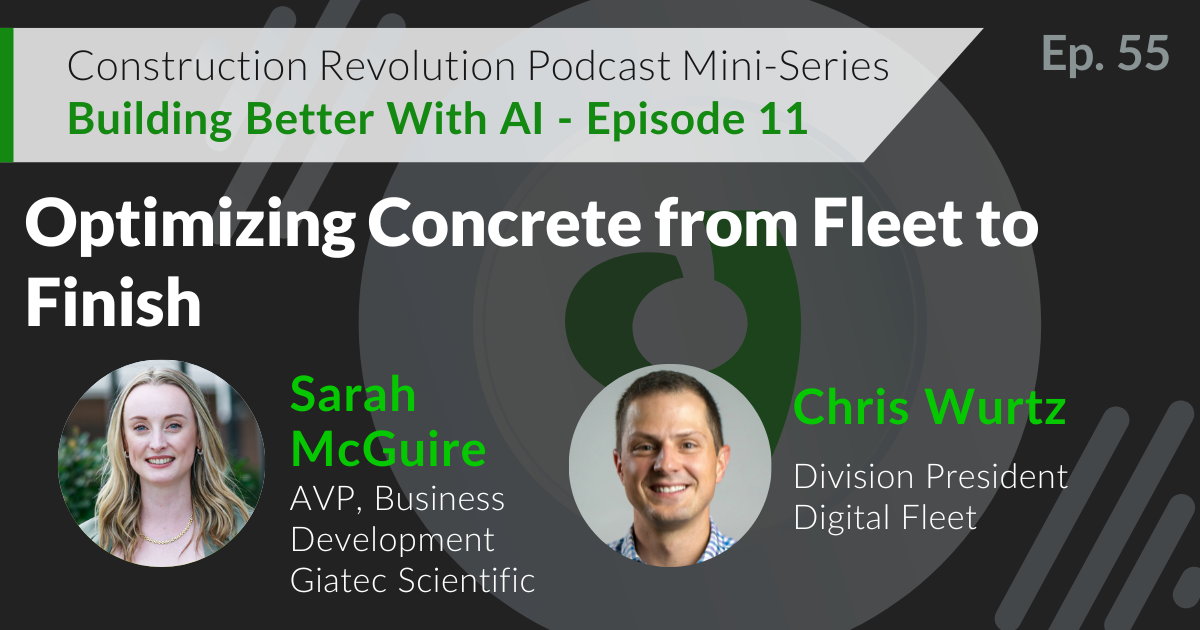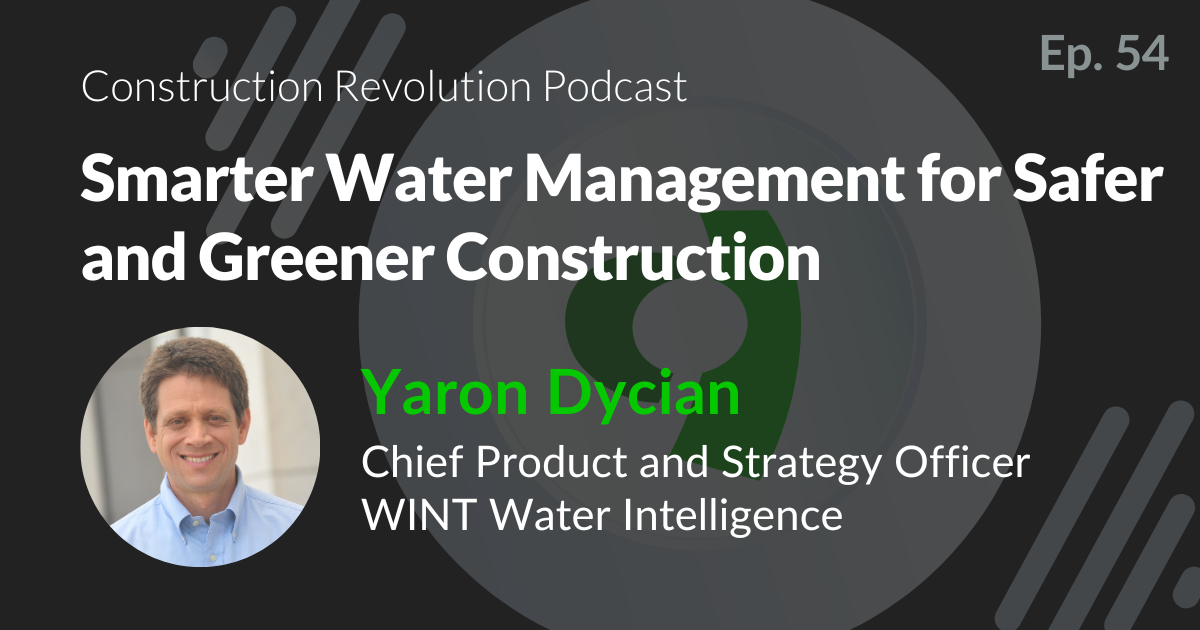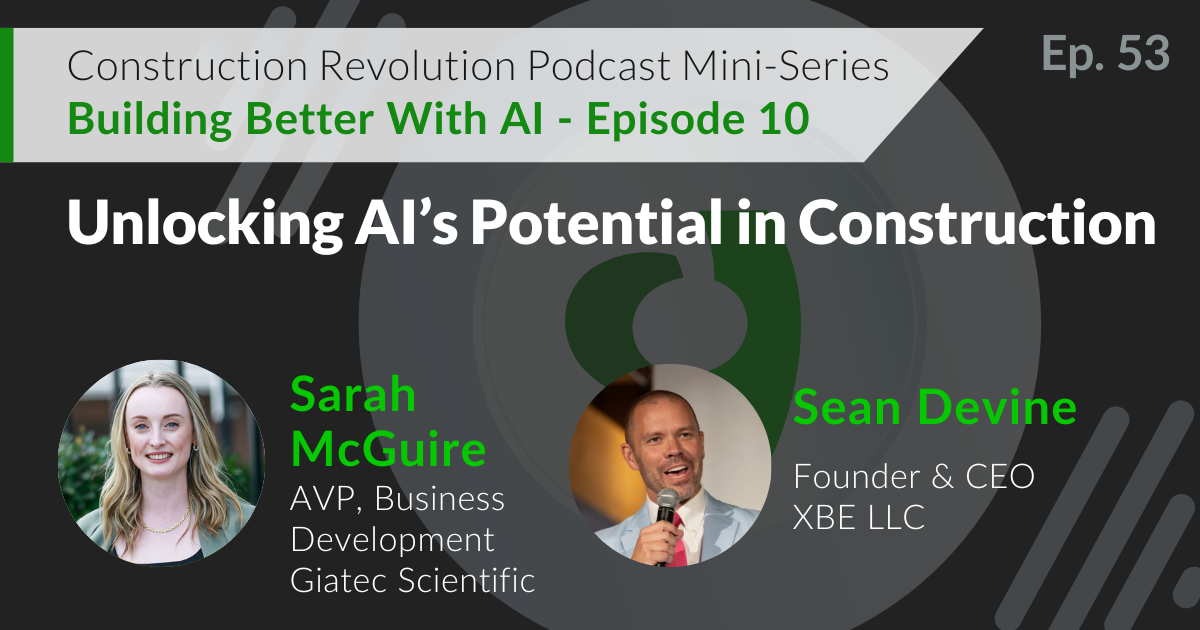
Episode 48 |
August 22, 2024
Streamlining Green Construction with EPDs
In This Episode
In this episode of The Construction Revolution Podcast, we welcome Chris Erickson of Climate Earth. Chris shares how the latest advancements in Environmental Product Declarations (EPDs) are transforming sustainability efforts in the construction industry. With his extensive knowledge in environmental impact data and sustainable practices, Chris delves into the innovative tools and solutions that are simplifying EPD creation and management for construction companies. Join us as Chris discusses how Climate Earth’s technology is making it easier for companies to measure and reduce their ecological footprint, ensuring compliance with regulatory requirements and enhancing their commitment to sustainability. Don’t miss this insightful conversation on the future of sustainable construction and the role EPDs play in leading the industry towards a greener future.

Host
Steven Rossi-Zalmons
Marketing & Events Lead, Giatec Scientific Inc.

Guest
Chris Erickson
Co-Founder, CEO, Climate Earth
Podcast Transcript
Steven Rossi:
Hello there and welcome to the Construction Revolution Podcast. My name is Steven Rossi, and here on the show, we explore the latest trends, technologies, people and organizations that are revolutionizing or disrupting the construction industry and are changing what the industry will look like tomorrow. Today, we have the pleasure of welcoming Chris Erickson, the CEO and co-founder of Climate Earth. With a deep-rooted passion for sustainability and a wealth of experience in environmental impact data, Chris has been instrumental in pioneering solutions that are transforming the construction industry’s approach to environmental responsibility. Under his leadership, Climate Earth has emerged as a leader in simplifying EPDs, making it easier for companies to measure and reduce their ecological footprint. We’re thrilled to have Chris with us today to share his insights on the intersection of technology, sustainability, and the future of construction.
All right. Thank you, Chris, for joining us today. How are you doing?
Chris Erickson:
I’m doing great. Thank you. How are you doing, Steven?
Steven Rossi:
I’m doing good. I’m excited to get to know more about Climate Earth and EPDs today. So let’s dive right in, and if you can tell me a bit about your journey and what inspired you in founding Climate Earth and the vision behind the company.
Chris Erickson:
I started the company actually quite a few years ago, but there was three premises around it. The discussion of building a sustainable economy was building quite rapidly back then, so I thought there was a major opportunity in sustainability in general. And then I looked at the discipline of what’s called life cycle assessment, which is the discipline that’s used to measure environmental impacts, and realized that it was highly labor-intensive and slow, and it was essentially the accounting system for the sustainable economy and felt like if we were going to move to a sustainable economy, that having a slow costly accounting system that would take months to get basic numbers was not going to be acceptable.
I had spent 25 years in Silicon Valley and started the company basically with the premise that its discipline of life cycle assessment should become automated and much more business friendly, and that ultimately led us to being the first in the world to automate environmental product declarations, which is the subject of our discussion.
Steven Rossi:
Yeah, no, that’s great. I was looking into your background and I saw a lot of it was in tech. So I’m wondering what made you want get into construction specifically going from your other tech background.
Chris Erickson:
Construction was actually somewhat serendipitous as we started the company looking at automating supply chain analysis, and we were not in construction. We were working with Fortune 500 companies such as the General Motors company using software technology to evaluate their $100 billion of annual purchases worldwide. And a company here in the San Francisco Bay Area called Central Concrete came to us in 2012, amazing number of years ago, and said that they wanted to be first in the industry with EPDs. And they said that because the general manager at the time sitting in Silicon Valley was selling to major tech companies who were already asking for new, more sustainable headquarters like Apple and Google, and he was serving the city of San Francisco, which was also a very early adopter of sustainable and low carbon materials.
And based on that relationship, we began to investigate and ultimately realize that EPDs might become a serious global phenomenon and that automating the industry in construction and in particular in ready-mix concrete would be a significant opportunity for the industry itself and, of course, for our company as well. So in 2013, we introduced the first EPD generator ever created in the world at Central Concrete, and I think it served them quite well in responding to their customers’ desires for more sustainable, reduced carbon concrete.
Steven Rossi:
Nice. That’s really interesting, that transition, and it seems like it’s worked well for you ever since. So for our listeners who aren’t familiar with environmental product declarations or EPDs, can you explain what those are?
Chris Erickson:
A very good question that we maybe should have started with. We’re throwing around acronyms like EPDs. I’m sure many of our listeners will know what they are. EPDs, as you said, stand for environmental product declarations. They are an internationally recognized standard, essentially a standard report that’s third-party verified for measuring the environmental impacts of any product, not only construction products, but any product manufactured around the world, and it measures the entire lifecycle impacts of that product in most cases, and it becomes the basis for companies measuring their environmental impacts.
It’s often referred to as equivalent to a nutrition label. An EPD is very similar to what we see in the food industry where you’re hanging a nutrition label on your product. A nutrition label though in this case shows the environmental impact of producing and, in many cases, using that product. It’s purely fact-based. It’s nonjudgmental. It’s not like putting a green sticker on your product. It simply says what are the facts, the environmental facts about this product.
Steven Rossi:
Okay. That’s great. Yeah. So in terms of construction, EPDs have taken off particularly in concrete. So I’m wondering if you can share why EPDs are so popular in concrete construction right now.
Chris Erickson:
Well, one reason that, I guess, some might think of as negative is that concrete and cement in particular, its primary ingredient, is 8% of global warming. So the industry is under a lot of pressure to reduce carbon. I think there’s more strategic and more positive reason for that. We often speak of concrete as the most widely used material in the world after water, but I don’t think that’s adequate. It’s also probably in my mind the most important strategic material for building out the modern infrastructure that supports everything we have and do in a modern social society, our roads, high-rise buildings, our homes. I mean, pretty much if it’s built, there’s concrete in it.
And we depend across the planet. Civilization depends on concrete to build out what we call civilization today. The entire infrastructure of civilization is built on concrete. So really, I think of it as concrete being in a transition period. We’re transitioning from a period where global warming impact or carbon impact was really not even looked at, and we’re transitioning the industry to continue to serve its role as building out the infrastructure of society in a reduced carbon way. And that’s, I think, a really important transition that the industry is going through.
And as the industry goes through that transition, our role is not to necessarily innovate new concrete mixes, but to give them the tools they need to rapidly measure those environmental impacts and through rapid measurement accelerate their ability to innovate and their ability to produce better low carbon concrete designs and new cements as well.
Steven Rossi:
Yeah, no, for sure. That’s great. I think it’s a great point. Concrete, as we all know, not great for the environment historically and also historically pretty slow to innovate, but with tools like Climate Earth, we can evaluate these new innovations that other companies and producers and even companies like ourselves at Giatec are working on to help optimizing mixed designs and reducing the impact of cement and of concrete, and tools like Climate Earth can help us evaluate and validate those a lot quicker than we would be able to do otherwise.
Chris Erickson:
Both Climate Earth and Giatec, I think, are great examples of a trend that’s now unstoppable in the industry, and that trend is moving to more efficient, more modern, digital and reduced carbon approach to the entire industry, and I think we’re both participating in that transition.
Steven Rossi:
Yeah, absolutely. I think the great part about it is reducing carbon, we’re also often reducing costs. So it’s not just reducing carbon for the sake of just the environmental impact, it also benefits the business as well.
Chris Erickson:
We’re reducing cost, and also, a lot of the new cements that are being produced as the glue in ready-mix concrete are not only lower costs, they’re higher performance. They’re more workable, they’re more durable, and you can produce higher strength concrete ready-mixes with less of the cement material. So there’s many, many benefits besides just reducing carbon. The more that we continue to innovate in the industry, I think the more benefits will be discovered along all of those dimensions, carbon, cost and constructability.
Steven Rossi:
Yeah, absolutely. That’s a great point. The being forced to innovate for the sake of becoming more environment friendly is leading us to all these new innovations that will help us in the long run, for sure. So going back to Climate Earth specifically, how does the tool simplify the process of creating and managing EPDs for construction companies?
Chris Erickson:
Well, first, I have to say I’m glad you used the word creating and also managing because they’re both important. As I mentioned in the beginning of our discussions, Climate Earth’s first major innovation was inventing the idea of automating EPDs. We did that and today we did that realizing that the creator of EPDs is not a life cycle assessment professional. They’re a concrete professional. Most of the people, in fact almost all the people that use and generate EPDs are concrete professionals. So we designed our software interface not for an LCA professional, but for a concrete professional.
So it’s very, very easy to use. It uses languages that they’re familiar with, and the system adopts to the specific producer’s language for materials and mixed designs and mixed codes, and all of that local direct knowledge about concrete is built into the user interface so it’s extremely easy to use. The second innovation we did was almost every concrete producer has what they call a quality control system, a QC system, and this is where they store all their mixes, and it usually also stores all the documentation they need to ensure that a concrete mix meets ASTM and other standards that they must submit whenever they submit a proposal or a bid to a new job.
We realized early on that if we integrate it with the major QC systems, that our customers who are living off in that QC system could simply then click a button on the QC system, send us the mix design with a single click and we return a fully verified EPD to them in seconds without even having to go to a separate user interface. So those two innovations, I think, were really important. That is, designing around the end user, the concrete producer and not the LCA person, and secondly, digitally integrating with the system they work with every day, their quality control system, and we do integrate with all the major ones in North America as well as in Europe.
Your second point was about managing, and EPDs are like mixed designs in the sense that there’s hundreds or thousands of mixed designs. Producers can create hundreds of EPDs as well. So in addition to generating a new EPD, we want to be able to give the concrete producer the ability to filter, sort, analyze, benchmark their EPDs so that they have a tool not only to create an EPD, but to understand them, evaluate them, figure out what’s the best EPD to send for this particular job or even edit that mix design if they can optimize the mix for a particular job. So it’s both a combination of making it easy to use to create an EPD, but also easy to use to manage the EPDs and the EPD data that they generate over a period of time as they use the system.
Steven Rossi:
Right. Yeah, no, that makes sense. I think designing any software for your end users is definitely the best way to do it and is going to, especially long-term, have the best impact for your users and then also for you as a business.
Chris Erickson:
Well, this is, I think, an advantage. We do focus on the concrete industry, and EPDs can very often come from LCA or ESG consultants that are generalist. And therefore, if you’re a generalist living in the lifecycle assessment world, you probably need to design your EPD data collection tools and other tools around what you know, which is the core technology used to create LCA or EPDs, and that’s LCA, not the concrete industry. So it’s a subtle but very important shift that by focusing on a particular industry, you can design to that industry’s need, not to the general business public for EPDs.
Steven Rossi:
Right. That’s a great point. So in terms of EPDs, a lot of ready-mix companies, especially the larger ones, are committing to either internal targets or in some cases, they may be regulatory targets that they’re aiming to hit. What trends are you seeing through your customers in getting to those targets?
Chris Erickson:
That’s a great question. I’ll step back a little bit and say that those targets are mostly regulatory in nature. I’m not a big fan, as an entrepreneur and a businessman, I’m not generally a big fan of regulation, but the regulation around EPDs, especially what we see coming out of the EPA and the general services administration, the US government are different than past regulations. Past regulations have been punitive. That is, if you pollute our river, you’re going to pay a huge fine.
The new regulations are if you can meet these low-carbon targets, we’re going to buy your product. That’s an enormous shift from punitive to more of a reward system. I think that’s a great thing. Like I said, I’m not a fan of regulation, but to make that shift is a terrific move by the government to create a positive motivation rather than a negative motivation.
That all said, that means that our tools, and we’ve implemented this need to be able to support what we call one-click benchmarks. So if a producer is designing mixes around a particular project, they can click a button on our console and see how that mix performs to the benchmark, whether that be the NRMCA industry average, the GSA target, and very soon now the CalGreen target, the California targets or the New York targets. We now see up to 38 states here in the US, and most of the provinces in Canada all have done average EPDs and many, many projects are wanting to meet or exceed those average numbers.
And we want to be able to support those targets and see how they’re doing relative to those targets with a simple click of a button on a console, and we do provide that level of technology. Those single clicks can be downloaded as reports and provided to the buyer of the concrete so that they can confirm the relative performance of the mixes to the benchmark. We think this is a critical need now in the industry that goes one small step beyond just generating an EPD, but actually verifying how it performs relative to all the benchmarks that are emerging across North America.
Steven Rossi:
Right. It’s definitely interesting to see all the regional specific benchmarks, so it’s great that you’re able to analyze for those so that people can address it for their specific project. So I’m wondering, in terms of Climate Earth, is there anything really exciting that you guys are working on? What do you see as the next iteration of Climate Earth and where are you guys heading down the road?
Chris Erickson:
I’ll answer that question. The answer is absolutely yes. We’ve built our company around the idea that we need to be one step ahead of the concrete industry, and so far, I think we’ve been successful at doing that. We see the next generation of EPDs shifting from being what I call a transactional system, I’m using software lingo here, but a transactional system is where you, in this case, enter a mix design and in seconds get back a fully verified EPD. That’s a transaction.
With all the new regulations and the transition of the entire industry to being more sustainable, we see that there’s going to be a shift, and we see this already happening from our customers from, “Okay. Get me an EPD as quickly as possible,” to, “Help me understand how my plants, how my company, and possibly even more so how my entire supply chain is supporting my sustainability initiatives.” So we’re shifting from a transactional nature, which we have to have that. Of course, that’s the basis of everything we do, but shifting to more of a strategic analysis of the system.
We’ve just introduced our first version of this, which we call our pro system, and it introduces a dashboard that covers every plant in the company, shows how that plant is performing to new standards. It shows how the sum of those plants across the entire producer are performing to those standards, and it allows management to dive into the company or the plant and evaluate, “Why is this plant a lower performing plant than this plant I have 150 miles away? What are they doing differently? How are they optimizing? How are they optimizing mixes? How do their supply chains compare? What can we do to improve the overall performance of our company, not just looking at individual mix designs?” That’s a fundamental strategic shift.
The other one that’s happening is, of course, one that Giatec is also participating in is sustainability is brand new, and the other issue that it touches is digitization of the concrete industry. This is where, I think, we share a lot of commonality and that you’re digitizing and offering new digital solutions. The beauty of sustainability is it’s all new, and it’s much easier to digitize something that you’ve never done before than retrofit digitization into a paper-based system that everybody in your entire supply chain is accustomed to. A truck driving up and handing the job site manager a piece of paper, it’s very different than … Now, changing that is really challenging.
Whereas we have essentially a green field where we can lead the effort to digitize the industry by connecting into IT systems, by digitizing reporting, by having our reports, our EPDs be digitally native rather than native paper-based or PDFs. And we’ve done all of those things. Everything in our company is digital. All the tools we provide are digital. We’ve invested heavily in integration with IT systems so that we can become part of the new emerging digital infrastructure and, in fact, possibly lead that.
So in summary, there’s two elements here. One is moving from a transactional to a strategic data system, and secondly, digitizing everything that we do so that the information can be interconnected and more usable by the producers across their supply chain.
Steven Rossi:
Yeah, no, that is really exciting. I think to your first point, I could see how valuable that’ll be for producers to be able to evaluate their entire operation as opposed to just independent mixes. That’s great. Your point of exactly what we’re doing at Giatec and you guys are doing at Climate Earth and a lot of all the innovative tech companies within construction, the ability to integrate and to share data and use all the data that we’re capturing to integrate with each other and those new systems and allow the industry to move forward is something that’s huge and also really exciting to be a part of as well.
Chris Erickson:
I think digitization, of course, I grew up as a digital guy, so seeing that happen and being part of it in an industry that historically has been a little bit behind, digitization is really exciting to me as well. Personally, I think it’s an area, there’s enormous opportunities for cost reduction and for efficiencies for the entire industry through digitization, and I think we can help by being on the forefront of that process with our customers.
Steven Rossi:
Yeah, for sure. So to wrap us up, if people are interested in getting started with Climate Earth, where should they go and what do those first steps look like?
Chris Erickson:
Well, let me just tell you, getting started is really simple. You can go to our website, which is climateearth.com, and there’s a button right on the homepage that says Request A Consultation. You press that button and we’ll be in touch with you within 24 hours. If you’re not a digital person and prefer good old-fashioned telephone processes, you can just step right up and give us a call at 415-391-2725.
The getting started process is actually quite easy. We’ve done over 1,000 plants in North America, and we have a trained staff of LCA experts who speak concrete. Every single one of them does nothing but work with concrete companies every day, and they will guide you through what is the first phase, which is a data collection process by meeting with you weekly, meeting with the concrete producers. They’ll get your data into our system, and at that point, we’ll just take over and develop your initial EPDs, design your EPD look and feel, produce a technical report, turn that over to a verifier, and you’ll be up and running in a matter of a couple of two to three months. Maybe for these days, the verification process is slowing way down, but we hold the customer’s hand. We’re experts in doing the process, and we make it very, very easy to get started.
Steven Rossi:
Well, thank you so much, Chris, for joining us today and for your time and your expertise on EPDs and excited to see Climate Earth’s continued evolution.
Chris Erickson:
It’s great to be with you and having this conversation. It’s also exciting for us to see Giatec innovations and helping also move the concrete industry into this new era. So thanks a lot for interviewing us and we very much appreciate working with you.
Other Related Episodes
Episode 55 |
February 27, 2025
Optimizing Concrete from Fleet to Finish
In this latest episode, host Sarah McGuire speaks with Chris Wurtz, Division President at Digital Fleet, about the impact of data-driven decision-making in the ready-mix concrete industry. With expertise in fleet tracking technology, Chris sheds light on the challenges and opportunities of controlling what he calls a “factory on wheels”—the mixer truck. He explores the biggest obstacles facing producers today, from data limitations to inefficiencies in delivery, and highlights untapped opportunities to improve performance. Chris also discusses the vision behind Digital Fleet’s partnership with Giatec on MixPilot and how this integration is helping producers gain better control over their operations. Tune in for an insightful conversation on the future of ready-mix operations and how collaboration between technology providers is driving industry-wide transformation. Don’t miss this engaging discussion!
PLAY
Episode 54 |
February 6, 2025
Smarter Water Management for Safer and Greener Construction
In this episode of The Construction Revolution Podcast, Steven Rossi sits down with Yaron Dycian, Chief Product and Strategy Officer of WINT Water Intelligence. With over 25 years of experience driving strategy and innovation at leading companies like IBM and RSA, Yaron is leading the charge in AI-powered water management solutions. Tune in as Yaron shares the story of WINT, explores the rising challenges of water damage claims, and discusses how advanced monitoring and leak mitigation technologies are shaping the future of construction. From preventing costly damages to meeting sustainability standards and lowering carbon footprints, this episode offers valuable insights into how construction companies can stay ahead in a rapidly evolving industry.
PLAY
Episode 53 |
December 12, 2024
Unlocking AI’s Potential in Construction
In this latest episode, host Sarah McGuire sits down with Sean Devine, Founder and CEO, XBE, to explore the transformative role of AI in the construction industry. With a background in logistics and technology, Sean brings unique insights into the challenges and opportunities surrounding AI adoption in construction. Sean highlights untapped opportunities and discusses how XBE is leading the charge with innovative solutions, including AskConcrete— a groundbreaking answer engine powered by decades of NRMCA data, designed to tackle complex questions about ready-mixed concrete. From identifying industry limitations to exploring what companies need to do to embrace AI effectively, Sean offers a compelling roadmap for innovation. He also shares his journey in founding XBE and his mission to optimize heavy construction operations with cutting-edge technology. Tune in to gain valuable insights into how AI is shaping the future of construction. Don’t miss this enlightening discussion!
PLAY
Want to Be a Guest Speaker, Sponsor, or Just Have a Question for Us? Fill In the Form!




